The services sector is undoubtedly the biggest economic sector in the US as it accounts for nearly 70% of the country’s gross domestic product. It ...
Eco-friendly dry cleaning may offer a potential opportunity to new market entrants.
We earn commissions if you shop through the links below. Read more
Written by: Esther Strauss
Esther is a business strategist with over 20 years of experience as an entrepreneur, executive, educator, and management advisor.
Edited by: David Lepeska
David has been writing and learning about business, finance and globalization for a quarter-century, starting with a small New York consulting firm in the 1990s.
Published on August 10, 2021

Investment range
$9,000 - $52,000
Revenue potential
$84,000 - $500,000 p.a.
Time to build
0–3 months
Profit potential
$67,000 - $250,000 p.a.
Industry trend
Fragile
Commitment
Full-time
Here are the most important things to consider when starting your dry cleaning business:
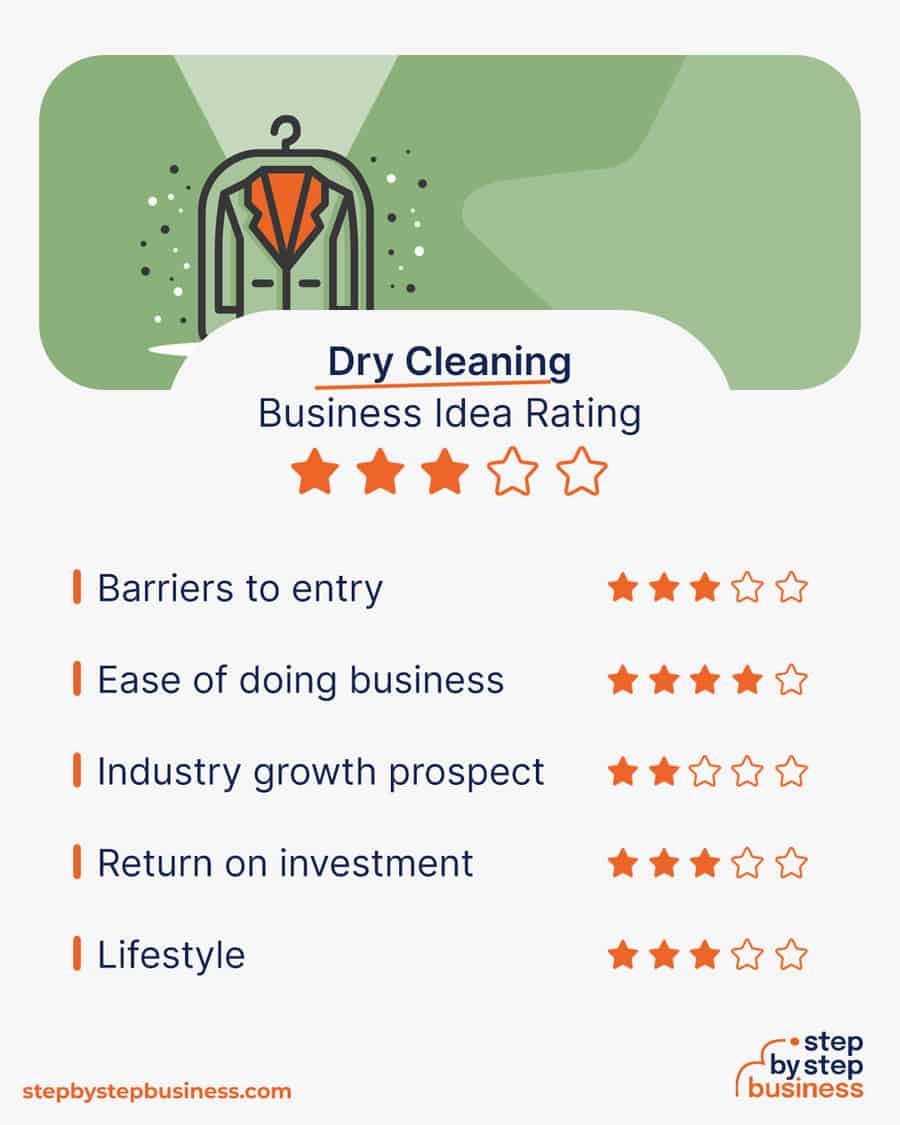
Before you launch a business, you should ensure it’s a good fit for you and your lifestyle. For instance, dry cleaning businesses offer a steady flow of income, but leave little scope for creativity.
Let’s take a look at some of the pros and cons of starting your own dry cleaning business:
Due to the sharp increase in working at home and the sharp decrease in going out, Covid-19 hit dry cleaning hard, forcing many businesses to close their doors. But now it’s begun to bounce back as consumers are likely to re-embrace dry cleaning services.
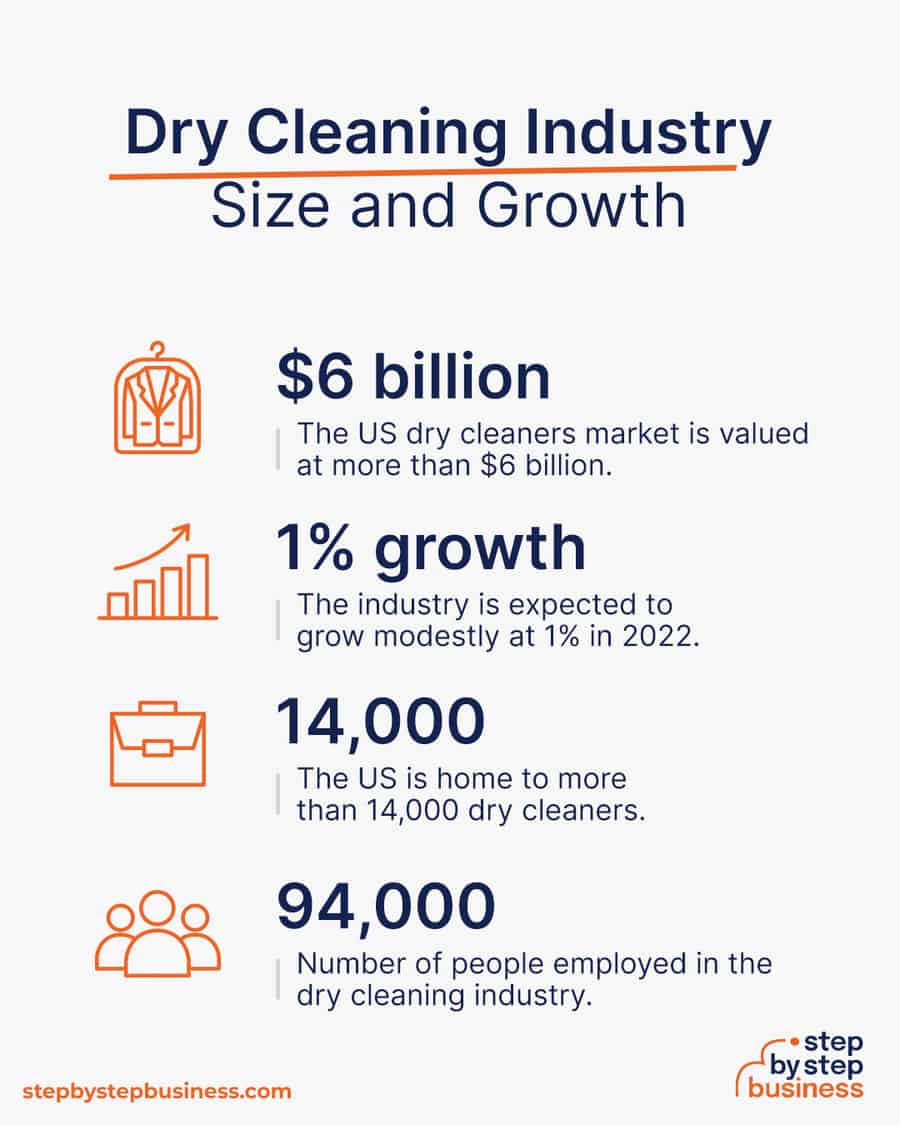
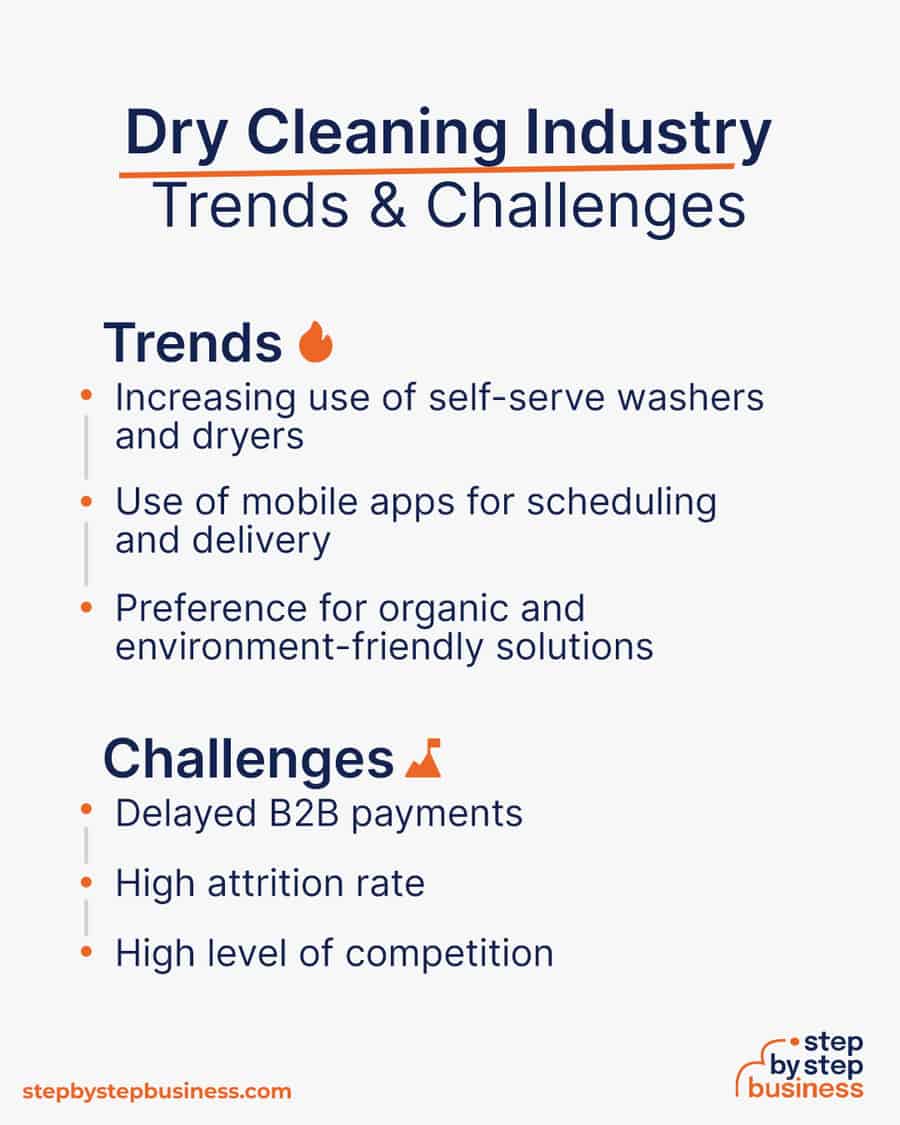
Trends shaping the dry cleaning industry include:
Challenges in the dry cleaning industry include:
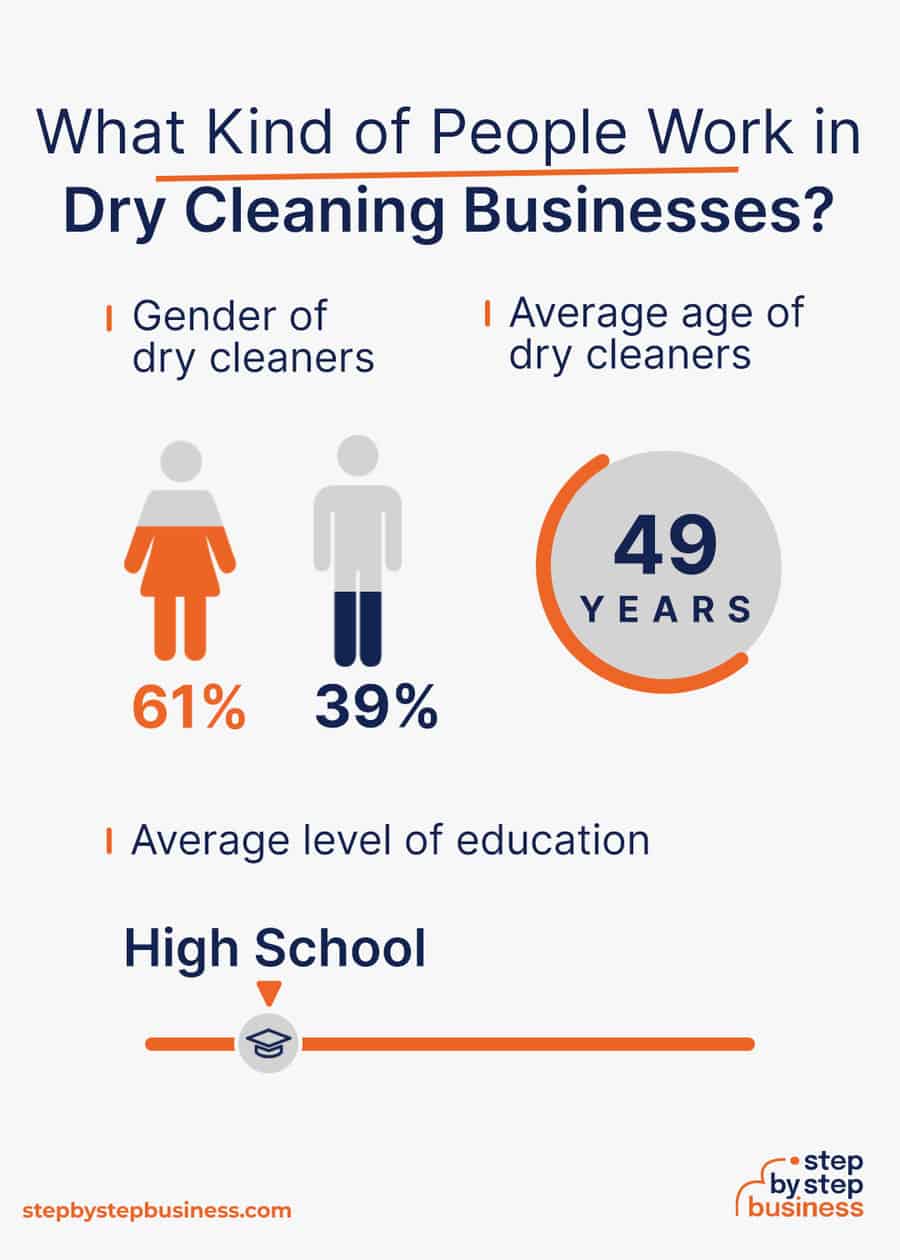
If you start out as a solopreneur, run your business from home, and use your personal vehicle for deliveries, it’s possible to start a dry cleaning business for as little as $8,000. At the other end of the scale, starting a full-service dry cleaning storefront could cost $50,000 or more. On average, it costs $30,500 to start a dry cleaning business.
You’ll need a handful of items to successfully launch your dry cleaning business. Here’s a list to get you started:
The major costs are procuring dry cleaning equipment, a delivery van, and marketing and advertising.
| Start-up Costs | Ballpark Range | Average |
|---|---|---|
| Licenses and permits | $200 - $800 | $500 |
| Insurance | $200 - $400 | $300 |
| Branding, marketing, and advertising | $1,500 - $5,000 | $3,250 |
| Website | $200 - $1,000 | $600 |
| Hiring | $0 - $300 | $150 |
| Machines and equipment | $5,000 - $30,000 | $17,500 |
| Shop decor and furnishing | $0 - $3,000 | $1,500 |
| Delivery vehicle | $0 - $7,500 | $3,750 |
| Software | $100 - $200 | $150 |
| Cleaning chemicals/supplies | $1,000 - $2,000 | $1,500 |
| Miscellaneous | $800 - $1,800 | $1,300 |
| Total | $9,000 - $52,000 | $30,500 |
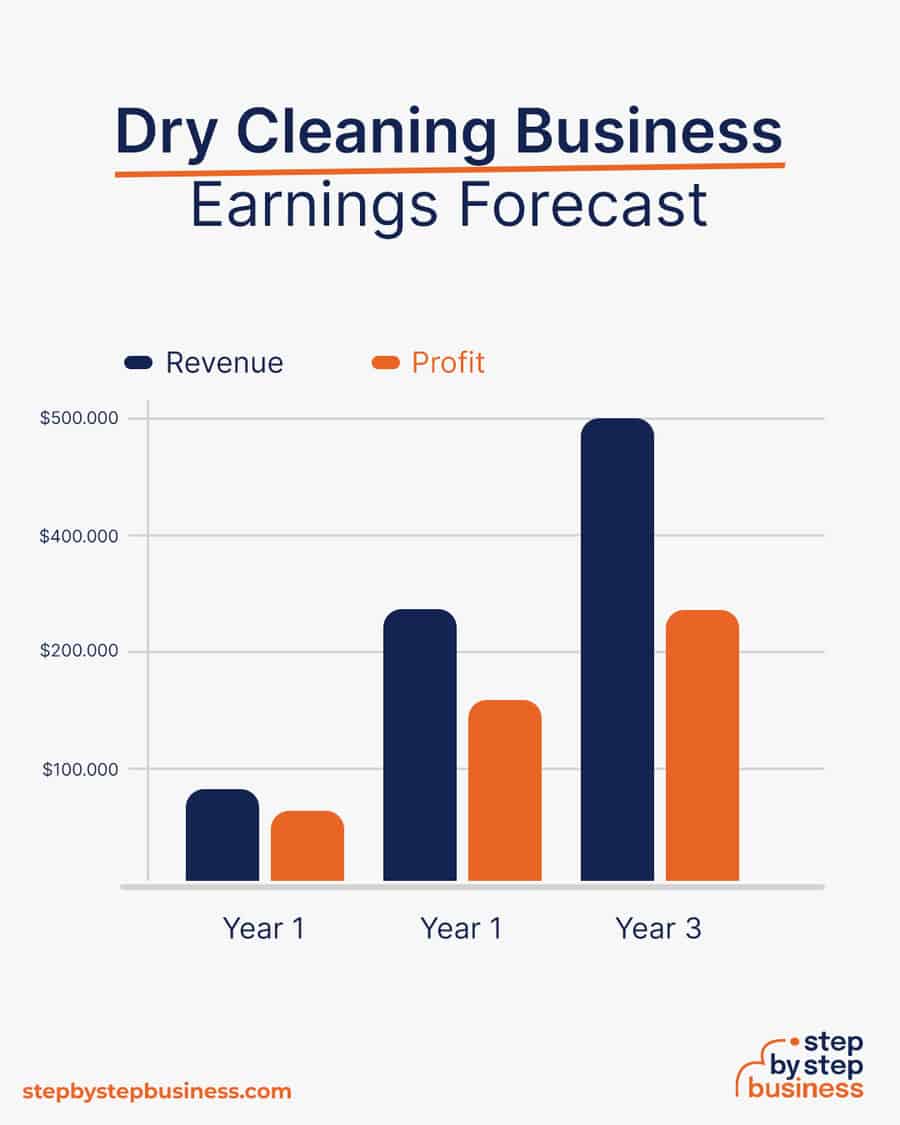
The average annual revenue for a US dry cleaner is about $250,000, but those starting out on their own should probably expect to bring in about a third of that total. With $84,000 in annual revenue and an 80% profit margin while operating from home, you can expect a profit of around $67,000.
A medium-sized dry cleaning shop with a good location can expect to hit the industry average of $250,000 in annual revenue. But with higher operating costs, particularly rent, your margin will fall to 60%. Still, that leaves a healthy profit of more than $150,000.
One of the benefits of the dry cleaning industry is that it lends itself to scaling up. Once your flagship store is established, you might look to open branches in other prime locations. Within a few years, you could have five branches bringing in a total of more than $500,000. Assuming a 50% margin due to increased operating expenses, your pre-tax profit would be a cool quarter of a million dollars.
The dry cleaning industry has few barriers to entry.
As a business dependent upon expendable income, the dry cleaning market shrinks when times are tough. Also, entrenched dry cleaning franchises like Martinizing.com tend to enjoy high client loyalty, so establishing your own reputation and drawing customers can be a significant hurdle.
Market research will give you the upper hand, even if you’re already positive that you have a perfect product or service. Conducting market research is important, because it can help you understand your customers better, who your competitors are, and your business landscape.
To give your new dry cleaning business the best possible chance of success, before you launch you should conduct in-depth market research in your area.
Identify all competitors within a five-mile radius and examine their service offerings, price points, and online customer reviews. Which services sell well in your area, and what might this market be missing? Consider how you might capitalize on your competitors’ weaknesses or beat them on their strengths.
One trend you might take advantage of is that customers are increasingly preferring “green” dry cleaners that embrace eco-friendly methods instead of harmful chemicals. The Eco Laundry Company is one example of a company that has successfully made this a selling point.
Eco-friendly dry cleaning may offer a potential opportunity to new market entrants.
Once you’ve compiled your research on competitors and customers, look for the best way to position your company in the local market.
The main service offered by a dry cleaner is, as the name suggests, washing clothes without water. Instead, water-free chemical fluids are used to strip away the dirt without harming delicate fabrics. But you could also offer supplementary services to boost revenue, such as alterations, steaming and ironing, and storage.
Prices vary based on fabrics and location, but a reasonable average is $5 for a shirt up to $30 for a comforter. Blouses, pants, skirts, sweaters, blazers and jackets are often $10 each, while dresses and suits cost $20. Overall, dry cleaning should average about $10 per item.
Once you know your costs, you can use this Step By Step profit margin calculator to determine your mark-up and final price points. Remember, the prices you use at launch should be subject to change if warranted by the market.
For most dry cleaning businesses, your main customers will be locals who regularly wear high-end clothes for work and events. Take the time to understand the demographics of your area, and how many customers you might have. You could also boost revenue by working with area businesses, such as hotels, restaurants, hospitals, and fast food outlets.
Choosing the right location for your dry cleaning business is essential for attracting customers and ensuring its success. Look for a spot in a high-traffic area with good visibility, such as a busy shopping district or a popular downtown area.
Consider accessibility and convenience, ensuring that the location is easily reachable by public transportation and has ample parking.
By strategically choosing the right location, you can establish a profitable and successful dry cleaning business that caters to a wide range of customers and stands out in the competitive cleaning industry.
You can find commercial space to rent in your area on sites such as Craigslist, Crexi, and Instant Offices.
Here are some ideas for brainstorming your business name:
Discover over 290 unique dry cleaning business name ideas here. If you want your business name to include specific keywords, you can also use our dry cleaning business name generator. Just type in a few keywords and hit “generate” and you’ll have dozens of suggestions at your fingertips.
Once you’ve got a list of potential names, visit the website of the US Patent and Trademark Office to make sure they are available for registration and check the availability of related domain names using our Domain Name Search tool below. Using “.com” or “.org” sharply increases credibility, so it’s best to focus on these.
Finally, make your choice among the names that pass this screening and go ahead with domain registration and social media account creation. Your business name is one of the key differentiators that sets your business apart. Once you pick your company name, and start with the branding, it is hard to change the business name. Therefore, it’s important to carefully consider your choice before you start a business entity.
Here are the key components of a business plan:

If you’ve never created a business plan, it can be an intimidating task. You might consider hiring a business plan specialist to create a top-notch business plan for you.
Registering your business is an absolutely crucial step — it’s the prerequisite to paying taxes, raising capital, opening a bank account, and other guideposts on the road to getting a business up and running.
Plus, registration is exciting because it makes the entire process official. Once it’s complete, you’ll have your own business!
Your business location is important because it can affect taxes, legal requirements, and revenue. Most people will register their business in the state where they live, but if you are planning to expand, you might consider looking elsewhere, as some states could offer real advantages when it comes to dry cleaning.
If you’re willing to move, you could really maximize your business! Keep in mind, it’s relatively easy to transfer your business to another state.
Business entities come in several varieties, each with its pros and cons. The legal structure you choose for your dry cleaning business will shape your taxes, personal liability, and business registration requirements, so choose wisely.
Here are the main options:

We recommend that new business owners choose LLC as it offers liability protection and pass-through taxation while being simpler to form than a corporation. You can form an LLC in as little as five minutes using an online LLC formation service. They will check that your business name is available before filing, submit your articles of organization, and answer any questions you might have.
Choose Your State
The final step before you’re able to pay taxes is getting an Employer Identification Number, or EIN. You can file for your EIN online or by mail or fax: visit the IRS website to learn more. Keep in mind, if you’ve chosen to be a sole proprietorship, you can simply use your social security number as your EIN.
Once you have your EIN, you’ll need to choose your tax year. Financially speaking, your business will operate in a calendar year (January–December) or a fiscal year, a 12-month period that can start in any month. This will determine your tax cycle, while your business structure will determine which taxes you’ll pay.
The IRS website also offers a tax-payers checklist, and taxes can be filed online.
It is important to consult an accountant or other professional to help you with your taxes to ensure you are completing them correctly.
Securing financing is your next step and there are plenty of ways to raise capital:
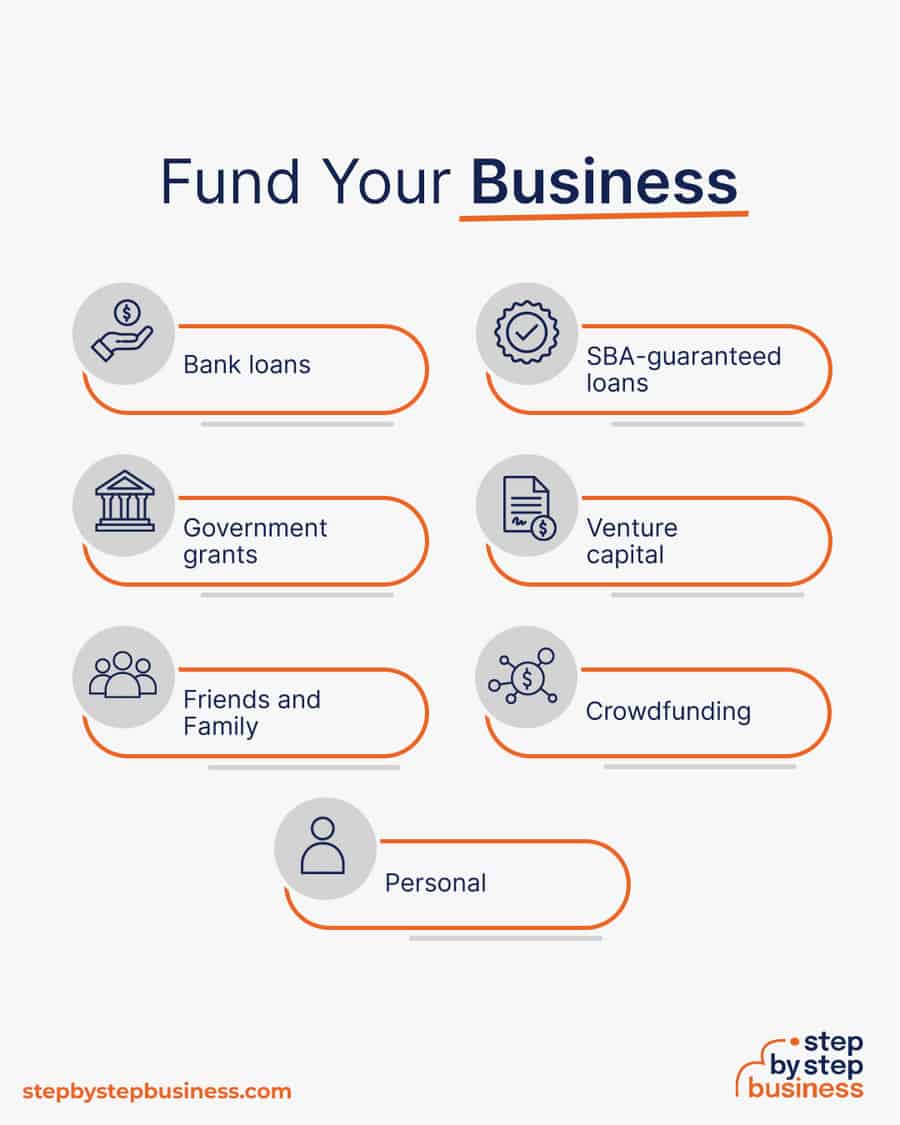
Bank and SBA loans are probably the best options, other than friends and family, for funding a dry cleaning business. You might also try crowdfunding if you have an innovative concept.
Starting a dry cleaning business requires obtaining a number of licenses and permits from local, state, and federal governments.
Federal regulations, licenses, and permits associated with starting your business include doing business as (DBA), health licenses and permits from the Occupational Safety and Health Administration (OSHA), trademarks, copyrights, patents, and other intellectual properties, as well as industry-specific licenses and permits.
You may also need state-level and local county or city-based licenses and permits. The license requirements and how to obtain them vary, so check the websites of your state, city, and county governments or contact the appropriate person to learn more.
You could also check this SBA guide for your state’s requirements, but we recommend using MyCorporation’s Business License Compliance Package. They will research the exact forms you need for your business and state and provide them to ensure you’re fully compliant.
This is not a step to be taken lightly, as failing to comply with legal requirements can result in hefty penalties.
If you feel overwhelmed by this step or don’t know how to begin, it might be a good idea to hire a professional to help you check all the legal boxes.
Before you start making money you’ll need a place to keep it, and that requires opening a bank account.
Keeping your business finances separate from your personal account makes it easy to file taxes and track your company’s income, so it’s worth doing even if you’re running your dry cleaning business as a sole proprietorship. Opening a business bank account is quite simple, and similar to opening a personal one. Most major banks offer accounts tailored for businesses — just inquire at your preferred bank to learn about their rates and features.
Banks vary in terms of offerings, so it’s a good idea to examine your options and select the best plan for you. Once you choose your bank, bring in your EIN (or Social Security Number if you decide on a sole proprietorship), articles of incorporation, and other legal documents and open your new account.
Business insurance is an area that often gets overlooked yet it can be vital to your success as an entrepreneur. Insurance protects you from unexpected events that can have a devastating impact on your business.
Here are some types of insurance to consider:

As opening day nears, prepare for launch by reviewing and improving some key elements of your business.
Being an entrepreneur often means wearing many hats, from marketing to sales to accounting, which can be overwhelming. Fortunately, many websites and digital tools are available to help simplify many business tasks.
You could use dry cleaning management software, such as CleanCloud, SMRT Systems, Geelus, and Enlite POS, to streamline your operations and bookkeeping.
Website development is crucial because your site is your online presence and needs to convince prospective clients of your expertise and professionalism.
You can create your own website using website builders. This route is very affordable, but figuring out how to build a website can be time-consuming. If you lack tech-savvy, you can hire a web designer or developer to create a custom website for your business.
They are unlikely to find your website, however, unless you follow Search Engine Optimization (SEO) practices. These are steps that help pages rank higher in the results of top search engines like Google.
Here are some powerful marketing strategies for your future business:

Unique selling propositions, or USPs, are the characteristics of a product or service that sets it apart from the competition. Customers today are inundated with buying options, so you’ll have a real advantage if they are able to quickly grasp how your dry cleaning service meets their needs or wishes. It’s wise to do all you can to ensure your USPs stand out on your website and in your marketing and promotional materials, stimulating buyer desire.
Global pizza chain Domino’s is renowned for its USP: “Hot pizza in 30 minutes or less, guaranteed.” Signature USPs for your dry cleaning business could be:
You may not like to network or use personal connections for business gain. But your personal and professional networks likely offer considerable untapped business potential. Maybe that Facebook friend you met in college is now running a dry cleaning business, or a LinkedIn contact of yours is connected to dozens of potential clients. Maybe your cousin or neighbor has been working in dry cleaning for years and can offer invaluable insight and industry connections.
The possibilities are endless, so it’s a good idea to review your personal and professional networks and reach out to those with possible links to or interest in dry cleaning. You’ll probably generate new customers or find companies with which you could establish a partnership. Online businesses might also consider affiliate marketing as a way to build relationships with potential partners and boost business.
If you’re starting out small from home, you may not need any employees right away. But as your business grows, you will likely need workers to fill various roles. Potential positions for a dry cleaner include:
At some point, you may need to hire all of these positions or simply a few, depending on the size and needs of your business. You might also hire multiple workers for a single role or a single worker for multiple roles, again depending on need.
Free-of-charge methods to recruit employees include posting ads on popular platforms such as LinkedIn, Facebook, or Jobs.com. You might also consider a premium recruitment option, such as advertising on Indeed, Glassdoor, or ZipRecruiter. Further, if you have the resources, you could consider hiring a recruitment agency to help you find talent.
So, you’re entering into a highly competitive industry. You can still succeed and capture a share of the market. You can do this by serving a particular niche or offering something new. It could be a service backed by the latest technology, or a solution in response to the increasing demand for organic and environment-friendly cleaning products.
Whatever is more convenient for the consumers is sure to get the market’s attention. For example, you can introduce a mobile app that will make it more convenient to contract your services. With proper research, you should be able to make money in no time!
Dry cleaning business can be an extremely profitable business venture. Small company’s profit before corporate taxes may begin from $67,500 per annum and grow to $500,000 or beyond with additional branches and investment.
Yes. The advantages of starting a dry cleaning business outweighs its cons, hence making it a suitable business to launch.
Dry cleaning is similar to laundering with the main difference being the use of water. Laundry uses water and other detergents while dry cleaning does not use water and removes stains and dirts through chemical solvents.
To get clients for your dry cleaning business, advertise in local media, maintain an active online presence, and encourage customer referrals. Target specific markets like hotels and restaurants, and build partnerships with local businesses to expand your reach.
The liquid commonly used in dry cleaning is perchloroethylene (perc), although the industry is shifting towards more environmentally friendly alternatives like hydrocarbon-based solvents or liquid carbon dioxide (CO2) systems.
Delicate fabrics like silk or lace, clothing with embellishments or beading, and items with leather or fur trims are not suitable for dry cleaning.

Published on December 1, 2022
The services sector is undoubtedly the biggest economic sector in the US as it accounts for nearly 70% of the country’s gross domestic product. It ...
Read Now
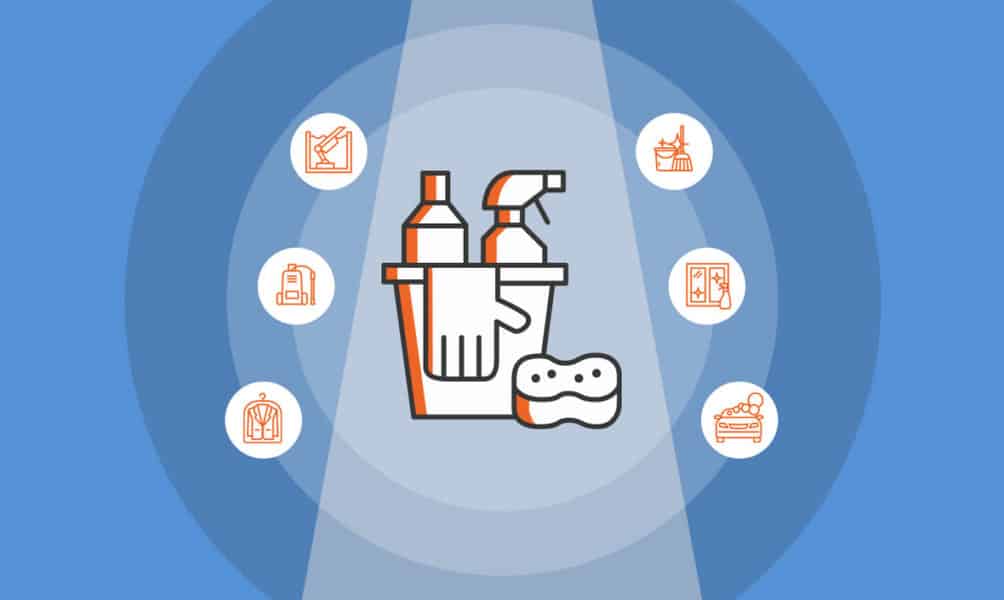
Published on July 14, 2022
Demand for cleaning services in both homes and offices surged in the last two years because of the COVID-19 pandemic. It is expected to remain higha ...
Read Now

Published on July 12, 2022
Part-time work enables countless people to make good money while also taking care of priorities, like helping moms care for their children orstudent ...
Read Now
No thanks, I don't want to stay up to date on industry trends and news.
I would like to know how to get some information about starting a dry cleaning (brims and baseball hats) business. It’s about having it programmed. It’s on a shaper, so it doesn’t lose its shape. Can you help me with what I need to get? The main thing will have to be the equipment.